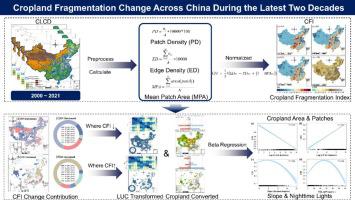当前位置:
X-MOL 学术
›
Agric. Syst.
›
论文详情
Our official English website, www.x-mol.net, welcomes your feedback! (Note: you will need to create a separate account there.)
Cropland fragmentation change across China over the last two decades
Agricultural Systems ( IF 6.1 ) Pub Date : 2024-05-25 , DOI: 10.1016/j.agsy.2024.104010 Na Zhao , Kainan Chen , Xiaoran Wu , Lili Zhang , Wei Wang
Agricultural Systems ( IF 6.1 ) Pub Date : 2024-05-25 , DOI: 10.1016/j.agsy.2024.104010 Na Zhao , Kainan Chen , Xiaoran Wu , Lili Zhang , Wei Wang

|
There is an urgent need for a comprehensive assessment of cropland fragmentation that can provide valuable insights for guiding policies related to cropland protection, restoration, and other relevant measures. Despite the growing number of studies focusing on cropland fragmentation, a nationwide, long-term, and fine-scale understanding of the spatiotemporal changes in cropland fragmentation across China remains lacking. This study aimed to construct a novel comprehensive index that quantitatively assesses the level of farmland fragmentation, to fully elucidate the spatial and temporal dynamics of farmland fragmentation in China at the county level over the last two decades, and to identify the relationships between farmland fragmentation and key factors from anthropogenic and natural perspectives. Utilizing the 30 m annual and continuous time series Landsat-derived annual China land cover dataset (CLCD) from 2000 to 2021, we integrated three landscape pattern metrics- patch density (PD), mean patch area (MPA), and edge density (ED)- to devise a new comprehensive cropland fragmentation index (CFI). We also developed a Beta regression method to identify the relationships between CFI and key factors from human and natural perspectives. The results show that counties with high cropland fragmentation (CFI > 0.8) are predominantly located in the central part of China and the coastal areas, and the counties with low cropland fragmentation (CFI < 0.2) are mainly in the North China Plain, the Northeast Plain, and some areas in the northwest. Among counties experiencing an increase or decrease in fragmentation, the primary types of cropland conversions are between cropland and grassland, as well as between cropland and forests. A third major type of conversion involves the transformation of cropland into impervious surfaces. CFI had a significantly negative linear relationship with total area of cropland in each county while showing a positive relationship with the total cropland patches in each county. The variables CFI and slope, and CFI and nighttime light (NTL) data, exhibited a quadratic parabolic relationship. The findings presented in this study provide crucial insights into the underlying causes and patterns of farmland fragmentation in China. These insights will serve as a valuable resource for policymakers and land managers, enabling them to devise effective strategies for sustainable land use planning and promoting rural development in the country.
更新日期:2024-05-25
















































 京公网安备 11010802027423号
京公网安备 11010802027423号